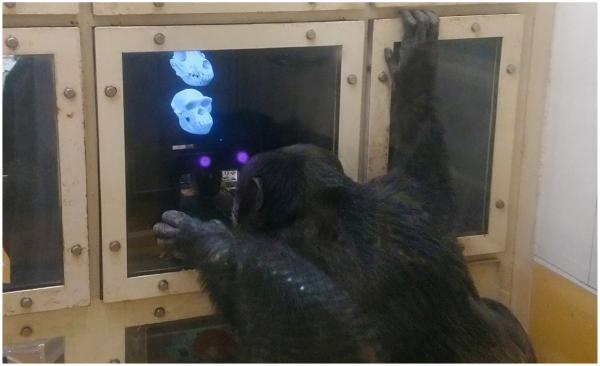



|
TOPICS BONOBO Chimpanzee "Ai" Crania photos Itani Jun'ichiro archives Open datasets for behavioral analysis Guidelines for Care and Use of Nonhuman Primates(pdf) Study material catalogue/database Guideline for field research of non-human primates 2019(pdf) Primate Genome DB 
Primate Research Institute, Kyoto University Copyright (c) |
Japanese Staring death in the face: chimpanzees' attention towards conspecific skulls and the implications of a face module guiding their behaviour
André Gonçalves, Yuko Hattori and Ikuma Adachi
Abstract
Chimpanzees exhibit a variety of behaviours surrounding their dead, although much less is known about how they respond towards conspecific skeletons. We tested chimpanzees' visual attention to images of conspecific and non-conspecific stimuli (cat/chimp/dog/rat), shown simultaneously in four corners of a screen in distinct orientations (frontal/diagonal/lateral) of either one of three types (faces/skulls/skull-shaped stones). Additionally, we compared their visual attention towards chimpanzee-only stimuli (faces/skulls/skull-shaped stones). Lastly, we tested their attention towards specific regions of chimpanzee skulls. We theorized that chimpanzee skulls retaining face-like features would be perceived similarly to chimpanzee faces and thus be subjected to similar biases. Overall, supporting our hypotheses, the chimpanzees preferred conspecific-related stimuli. The results showed that chimpanzees attended: (i) significantly longer towards conspecific skulls than other species skulls (particularly in forward-facing and to a lesser extent diagonal orientations); (ii) significantly longer towards conspecific faces than other species faces at forward-facing and diagonal orientations; (iii) longer towards chimpanzee faces compared with chimpanzee skulls and skull-shaped stones, and (iv) attended significantly longer to the teeth, similar to findings for elephants. We suggest that chimpanzee skulls retain relevant, face-like features that arguably activate a domain-specific face module in chimpanzees' brains, guiding their attention.  Ayumu performing an eye-tracking session in the experimental booth.
Bibliographic information
Gonçalves A, Hattori Y, AdachiI. (2022). Staring death in the face: chimpanzees' attention towards conspecific skulls and the implications of a face module guiding their behaviour. R. Soc. Open Sci.9: 210349. https://doi.org/10.1098/rsos.210349 2022/03/23 Primate Research Institute
|